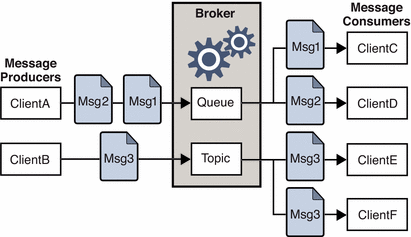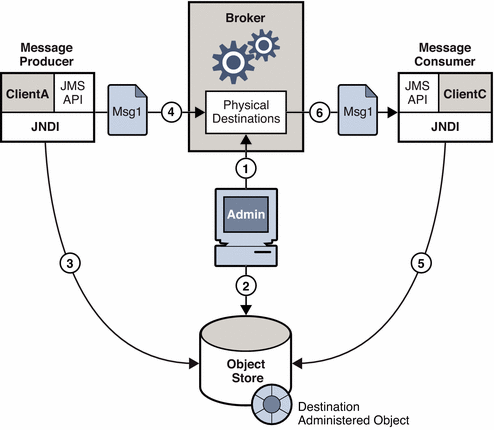JMS as a MOM Standard
The Java Messaging Service specification was originally developed to allow Java applications access to existing MOM systems. Since its introduction, it has been adopted by many existing MOM vendors and it has been implemented as an asynchronous messaging system in its own right.
In creating the JMS specification, its designers wanted to capture the essential elements of existing messaging systems. These included
-
The concept of a messaging provider that routes and delivers messages
-
Distinct messaging patterns or domains such as point-to-point messaging and publish/subscribe messaging
-
Facilities for synchronous and asynchronous message receipt
-
Support for reliable message delivery
-
Common message formats such as stream, text, and byte
Vendors implement the JMS specification by supplying a JMS provider consisting of libraries that implement the JMS interfaces, of functionality for routing and delivering messages, and of administrative tools that manage, monitor, and tune the messaging service. Routing and delivery functions can be performed by a centralized message server or broker, or they could be implemented through functionality that is part of each client’s runtime.
Equally, a JMS provider can play a variety of roles: it can be created as a stand-alone product or as an embedded component in a larger distributed runtime system. As a standalone product, it could be used to define the backbone of an enterprise application integration system; embedded in an application server, it could support inter-component messaging. For example, J2EE uses a JMS provider to implement message-driven beans and to allow EJB components to send and receive messages.
To have created a standard that included all features of existing systems would have resulted in system that was hard to learn and difficult to implement. Instead, JMS defined a least common denominator of messaging concepts and features. This resulted in a standard that is easy to learn and that maximizes the portability of JMS applications across JMS providers. It’s important to note that JMS is an API standard, not a protocol standard. It is easy to move a JMS client from one vendor to another. But different JMS vendors typically cannot communicate directly with one another.
The next section describes the basic objects and messaging patterns defined by the JMS specification.
JMS Messaging Objects and Patterns
In order to send or receive messages, a JMS client must first connect to a JMS provider which is often implemented as a message broker: the connection opens a channel of communication between the client and the broker. Next, the client must set up a session for creating, producing, and consuming messages. You can think of the session as a stream of messages defining a particular conversation between the client and the broker. The client itself is a message producer and/or a message consumer. The message producer sends a message to a destination that the broker manages. The message consumer accesses that destination to consume the message. The message includes a header, optional properties, and a body. The body holds the data; the header contains information the broker needs to route and manage the message; and the properties can be defined by client applications or by a provider to serve their own needs in processing messages. Connections, sessions, destinations, messages, producers, and consumers are the basic objects that make up a JMS application.
Using these basic objects, a client application can use two messaging patterns (or domains) to send and receive messages. These are shown in Figure 1–4.
Figure 1–4 JMS Messaging Patterns

Clients A and B are message producers, sending messages to clients C, D, and E by way of two different kinds of destinations.
-
Messaging between clients A, C, and D illustrates the point-to-point pattern. Using this pattern, a client sends a message to a queue destination from which only one receiver may get it. No other receiver accessing that destination can get that message.
-
Messaging between clients B, E, and F illustrates the publish/subscribe pattern. Using this broadcast pattern, a client sends a message to a topic destination from which any number of consuming subscribers can retrieve it. Each subscriber gets its own copy of the message.
Message consumers in either domain can choose to get messages synchronously or asynchronously. Synchronous consumers make an explicit call to retrieve a message; asynchronous consumers specify a callback method that is invoked to pass a pending message. Consumers can also filter out messages by specifying selection criteria for incoming messages.
Administered Objects
The JMS specification created a standard that combined many elements of existing MOM systems without attempting to exhaust all possibilities. Rather, it sought to set up an extensible scheme that could accommodate differences and future growth. JMS leaves a number of messaging elements up to the individual providers to define and implement. These include load balancing, standard error messages, administrative APIs, security, the underlying wire protocols, and message stores. The next section, Message Queue: Elements and Features describes how Message Queue implements many of these elements and how it extends the JMS specification.
Two messaging elements that JMS does not completely define are connection factories and destinations. Although these are fundamental elements in the JMS programming model, there were so many existing and anticipated differences in the ways providers define and manage these objects, that it was neither possible nor desirable to create a common definition. Therefore, these two objects, rather than being created programmatically, are normally created and configured using administration tools. They are then stored in an object store, and accessed by a JMS client through standard JNDI lookups.
-
Connection factory administered objects are used to generate a client’s connections to the broker. They encapsulate provider-specific information that governs certain aspects of messaging behavior: connection handling, client identification, message header overrides, reliability, and flow control, and so on. Every connection derived from a given connection factory exhibits the behavior configured for that factory.
-
Destination administered objects are used to reference physical destinations on the broker. They encapsulate provider-specific naming (address-syntax) conventions and they specify the messaging domain within which the destination is used: queue or topic.
JMS clients are not required to look up administered objects; they can create these objects programmatically (which are then stored in the broker’s memory). For quick prototyping, creating these objects programmatically might be easiest. But for deployment in a production environment, looking up administered objects in a central repository makes it much easier to control and manage messaging behavior:
-
By using administered objects for connection factory objects, administrators can tune messaging performance by reconfiguring these objects. Performance can be improved without having to recode.
-
By using administered objects for physical destinations, administrators can control the proliferation of these destinations on the broker by requiring clients to access these preconfigured objects.
-
Administered objects shield developers from provider-specific implementation details and allow the code they develop for one provider to be portable to other providers with little or no change.
The use of administered objects adds a final wrinkle to the picture of the basic JMS application, which is shown in Figure 1–5.
Figure 1–5 Basic Elements of a JMS Application

Figure 1–5 shows how a message producer and a message consumer use a destination administered object to access the physical destination to which it corresponds. The marked steps denote the actions that need to be taken by the administrator and by the client applications to send and receive messages using this mechanism.
 To Use Administered Objects as Destinations
To Use Administered Objects as Destinations
-
The administrator creates a physical destination on the broker.
-
The administrator creates a destination administered object and configures it by specifying the name of the physical destination to which it corresponds and its type: queue or topic.
-
The message producer looks up the destination administered object using a JNDI lookup call.
-
The message producer sends a message to the destination.
-
The message consumer looks up the destination administered object where it expects to get messages.
-
The message consumer gets the message from the destination.
The process of using connection factory administered objects is similar. The administrator creates and configures a connection factory administered object using administration tools. The client looks up the connection factory object and uses it to create a connection.
Although the use of administered objects adds a couple of steps to the messaging process, it also adds robustness and portability to messaging applications.
- © 2010, Oracle Corporation and/or its affiliates
